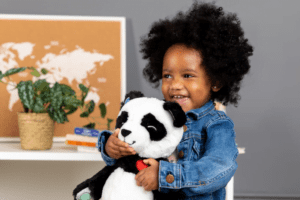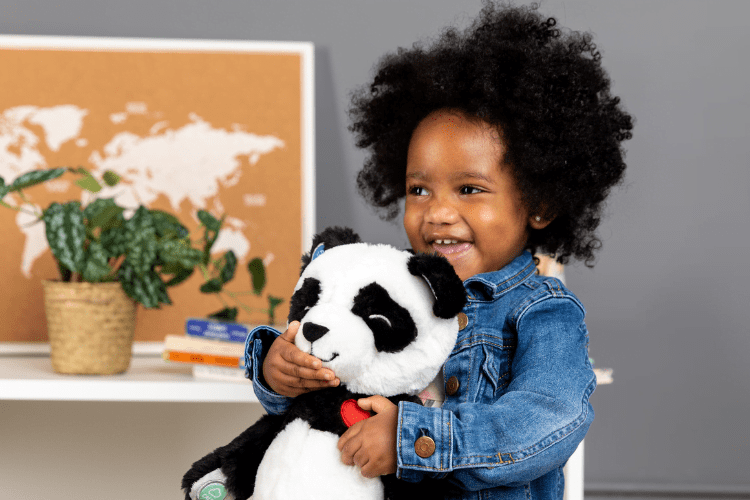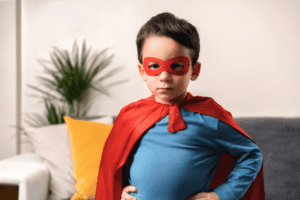
The Importance of Transitional Objects in Early Childhood
As a longtime educator of toddlers and twos and a doctoral student studying transitional phenomena and object relations, I have had the distinct pleasure and
Coming Soon – Reserve Yours Now

As a longtime educator of toddlers and twos and a doctoral student studying transitional phenomena and object relations, I have had the distinct pleasure and privilege to observe parents, teachers and caregivers dedicated to celebrating the presence of transitional objects in their early childhood classrooms.
I was delighted by the number of stuffed animals, rag dolls and teddy bears that were abundantly present and harmoniously integrated into the work and play of the children in the classrooms where I worked. In a classroom where early educators might expect objects of attachment to be mandated to bedrooms, backpacks, and family travels, I witnessed the integration of these beloved objects in numerous ways and in a variety of areas in the room.
According to the New York University Psychoanalytical Institute, “the transitional object may be conceived of in three ways: as typifying a phase in a child’s development; as a defense against separation anxiety and, lastly, as a neutral sphere in which experience is not challenged.” I was amazed how the transitional objects that found their way from home to school did not challenge the teachers in the particular classroom I was visiting.
I observed one child clutching her beloved dog while reading a book to her friend — both she and her dog were actively turning the pages — and with every page turned, she looked down at her dog, lovingly and with great appreciation and gratitude for his apparent contribution and cooperation. Another child was squishing, squeezing and stuffing his Snoopy inside a wooden block and alternatively opening the refrigerator door so his dear dog could “chill out.” I was struck by the level of self-awareness this particular child had for his own self-regulatory needs and how to meet them.
On the rug, two children were constructing a magna tile rooftop for two animals — one floppy ear extended carefully up and out of the construction, while a rainbow colored bear covered in band-aids was laying on top. These children were deep in conversation about their “hospital” and how their loved creatures would get better. And across the room, sitting on the floor in front of her cubby, a young girl was combing her fingers through her raggedy doll’s hair, another child was sitting with her oversized gingerbread doll, holding a phone to her ear, and placing one next to her doll, as she nodded in agreement that Mommy would come back after lunch, and another child was sitting in the dramatic play kitchen, feeding and clothing her bear, holding it close to her heart.
These children were utilizing transitional objects into their work and play — personified instruments of self expression — and this was synonymously supported, acknowledged and honored by their teachers.
The term transitional object was coined in 1951 by D.W. Winnicott as “a designation for any material to which an infant attributes a special value and by means of which the child is able to make the necessary shift from the earliest oral relationship with mother to genuine object-relationships.” Transitional objects are self-chosen — a child’s first “not-me possession” — like a blanket, teddy bear, pacifier, doll. The reliance on such objects is rooted in sensorial elements that lessen the stress and trauma of separation, while they soothe and comfort the child.
A transitional object provides an understanding of human development commencing with infancy and early childhood. As children procure and utilize transitional objects, this becomes indicative of how they will interact with others, maintain human relationships and encounter life cycles.
According to developmental psychologist Robert Kegan, human development is not possible without self-referential contexts and meanings. As Kegan states, “meanings are founded on the distinctions each person makes of the stimuli he or she engages with” — mainly the object(s) they receive, choose, or discover which have an internal life of their own. However, if the self-appointed object is refuted, critiqued, or denied in any way, attachment difficulties may arise later in life. The object allows for and invites emotional well-being, and without such an object, true feelings may be concealed, suppressed, or dismissed as the infant/child has no other means by which to cope with, comprehend, and contend with the world.
Transitional objects are representative of every human developmental milestone – both for the individual self and the differential other. It is the “other” that is synonymous with the external source of identification — albeit mother/father — and also the first “not me possession” — the transitional object which is self-chosen by a child to provide comfort, solace, predictability, and constancy — representational of a stable and predictable world.
Transitional objects typify that which is rudimentary and sound. In essence, the object represents the process by which one can navigate life, and experience a homeostatic inner balance, a cohesive sense of well-being at every developmental milestone.
According to Mark Brenner, transitional objects continue through the course of our lives, as “sacred keepsakes” which pull us back to “a place and time of great solace a memory.” It is the dependence, identification, and attachment to objects outside of the self — photographs, wedding bands, mementos, music, art and culture — which define both nostalgic memorials, but more importantly, and astutely, define a state of connection and presence in the world.
However, if the teddy, blanket or bottle misplaced or misbegotten — one may feel disconnected, removed, displaced. It is the placement, allocation of and attendance to transitional objects, which connects us to a secure base. And it is the secure base of human development that I am drawn to celebrating in the early childhood classrooms — supported, respected and honored by early childhood educators, which, according to psychologist Abraham Maslow, “matters more than anything else in the world.”
One of the unique aspects of Pause with Panda is that it leverages technology while still acting as a transitional object for children. Providing both comfort and instruction, Panda helps support child development by teaching emotion regulation in a way that is inherently comforting and alluring to children. Click here to learn more about Pause with Panda.

Share this article:

As a longtime educator of toddlers and twos and a doctoral student studying transitional phenomena and object relations, I have had the distinct pleasure and

Imagine that you’re looking for a place to hide some cookies so they don’t get eaten by someone else. You sneak into the kitchen when
Copyright © 2022 Pause with Panda, Inc. All Rights Reserved.